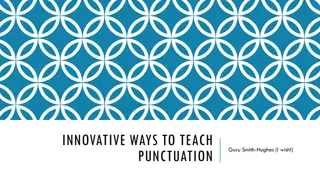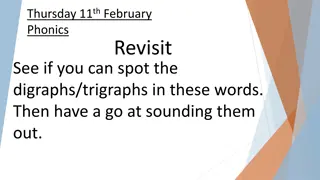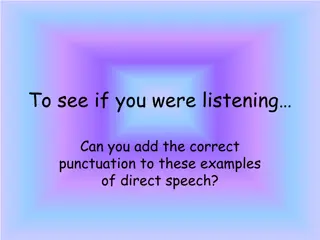Mastering Punctuation: A Guide to Handling Tricky Punctuation Marks
Explore the nuances of troublesome punctuation marks with examples borrowed from Bill Bryson's work, "A Dictionary of Troublesome Words." Unravel the mysteries behind apostrophes, learn about shared ownership, possessives, contractions, and exceptions. Delve into the correct use of colons and minor uses of apostrophes, and become versed in frustrating grammar nerds with tricky grammar rules.
Download Presentation

Please find below an Image/Link to download the presentation.
The content on the website is provided AS IS for your information and personal use only. It may not be sold, licensed, or shared on other websites without obtaining consent from the author. Download presentation by click this link. If you encounter any issues during the download, it is possible that the publisher has removed the file from their server.
E N D
Presentation Transcript
Troublesome Punctuation With examples blatantly stolen from Bill Bryson s A Dictionary of Troublesome Words.
The Apostrophe: Possessives. Contractions. NOT plurals. But what about multiple possessives?
In conditions of shared ownership: Example: Two cats share a single water dish. Incorrect: The white cat s and black cat s water dish. Correct: The white cat and black cat s water dish.
Do the cats have separate water dishes? The white cat s and the black cat s water dishes.
Use a possessive apostrophe for units of measure: Incorrect: Ms. Tanovitz had nineteen years experience. Correct: Ms. Tanovitz had nineteen years experience.
How to frustrate grammar nerds in three short letters. The possessive form of it is its . I-T-S. Note the lack of apostrophe. Note it again. Commit it to memory. Yes, it s a special-case rule, violating the general rule of using an apostrophe in possessives, but you can remember it. If you are using a contraction of it is , you should use an apostrophe: I-T- -S
Minor uses of the apostrophe To fill in missing figures in dates: The winter of 04 To fill in the omission of letters: Cat-o -nine tails I s pose we should have done something. Irish names Scarlet O Hara Eugene O Neill
Annoying exceptions N Sync (Proper Noun) Achilles Heel Should be Achilles s Heel (Long term use trumps consistent grammar) St. Thomas Hospital (Proper noun and long term use) Jeff Bridges performance (the name ends in an iz sound)
The colon : Marks an introduction or indicates the start of a series. Not used to separate a verb from its object. Incorrect: The four states bordering Texas are: New Mexico, Arkansas, Oklahoma, and Louisiana.
Correct: Texas is bordered by four states: New Mexico, Arkansas, Oklahoma, and Louisiana. Correct: The four states bordering Texas are New Mexico, Arkansas, Oklahoma, and Louisiana.
The comma, When do you need a comma? 1. Use a comma when the information provided is clearly parenthetical.
Correct: Mr. Lawson, the energy secretary, was unavailable for comment. Correct: The ambassador, who arrived in Britain two days ago, yesterday met with the Prime Minister. In both statements, the sentence would read clearly without the phrase between commas.
Parse this statement without the parenthetical phrase: At nine she won a scholarship to Millsfield, the private school, for bright children of the rich.
2. Use a comma when the information is nonrestrictive. Nonrestrictive: John Fowler s first novel, The Collector, was a bestseller. Restrictive (no comma needed): John Fowler's novel The Collector was a bestseller.
Incorrect: Mrs. Thatcher and her husband Denis left London yesterday. Correct: Mrs. Thatcher and her husband, Denis, left London yesterday.
3. Use a comma with forms of address. Incorrect: Good Morning America Correct: Good Morning, America
Are you telling Mr. Herriot that youre choking? Correct: I m choking, Mr. Herriot Incorrect I m choking Mr. Herriot
4. Optional: Use a comma with interpolated words or phrases. Interpolated words and phrases? However, moreover, so, fortunately, contrary to popular opinion...
Examples: "However, when the roads are wet..." "Meanwhile, on the other side of town..." Not always necessary, but recommended.
The Oxford Comma Which is correct? The colors of the flag are red, white, and blue. Vs. The colors of the flag are red, white and blue. The first is preferred in US English. The second is preferred in UK English. Yes, the Oxford Comma is the one preferred in US English.
In defense of the Oxford Comma Which is correct? I dedicate this novel to my parents, Ayn Rand, and God. I dedicate this novel to my parents, Ayn Rand and God.
The dash Used in pairs to enclose parenthetical matter. He fell there cold and bleeding on the stone marble floor. Used singly to indicate a sharp break in a sentence. He cried out but no one came. Used to emphasize a point. Use dashes sparingly not just to replace more appropriate punctuation.
Ellipsis... Used to indicate that material has been omitted. When ending a sentence with an ellipsis, a final period (making four, total) is not necessary.
The exclamation point! Used to show strong emotion. Correct: Look! Up in the sky! It s Superman! See Elliot S! Maggin Incorrect: Virtually anywhere in formal writing. Exception: Warnings.
The question mark? Appears at the end of a question. However, it shouldn't appear at the end of a sentence that isn't a question. Question marks appear at the end of direct questions, but not at the end of indirect questions.
Direct questions: How old are you? Why should I care?
Indirect questions: I asked how old you were. Tell me why I should care.
Quotation marks Punctuation goes inside the quotation marks. The Fish, Poetry, and The Monkeys are in Marianne Moore's Selected Poems.
For quotes within quotes, use a single quotation mark. He said I will not go. (Note: The general rule for quotes within quotes within quotes is to re-work your writing so these aren t required.)
Question marks in quotations: The question mark goes inside the quotation mark if the quotation is asking a question. Example: The child asked Will we be leaving soon?
The question mark goes outside the quotation mark if the overall statement is asking a question. Example: Did you just say I don t know ?
Avoid quotation marks around indirect quotations. Incorrect: After leaving the scene of the domestic quarrel, the officer said he was due for a coffee break.
Correct: After leaving the scene of the domestic quarrel, the officer said he was due for a coffee break. Better still: After leaving the scene of the domestic quarrel, the officer said he was due for a coffee break.
The semicolon; The semicolon connects independent clauses not joined by a conjunction. Injustice is relatively easy to bear; what stings is justice. - H.L. Mencken
It can also be used to separate items in a series containing internal punctuation. The only sensible ends of literature are first, the pleasurable toil of writing; second, the gratification of one's family and friends; and lastly, the solid cash. - Nathaniel Hawthorne























